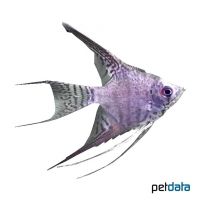Leopard Angelfish (Pterophyllum scalare var.)
| Leopard Angelfish Pterophyllum scalare var. | |
|---|---|
| Name | Leopard Angelfish |
| Name Lat. | Pterophyllum scalare var. |
| Family | Cichlids |
| Family lat. | Cichlidae |
| Order | Cichlids |
| Order lat. | Cichliformes |
| Origin | South America (breeding variety) |
| Habitat | Rivers, lakes |
| Diet | Omnivore |
| pH | 6.0-7.5 |
| Behavior | Peaceful |
| Keeping | Group |
| Care Level | Moderate |
| Reproduction | Substrate spawner |
| Breeding | Moderately difficult |
| Life Span | 5-10 years |
| Protection | No |
| Metric Units | |
| Size | 15 cm |
| Temperature | 24-30 °C |
| Hardness | 5-15 °dH |
| Aquarium | ~ 350 l |
| US Units | |
| Size | 6" |
| Temperature | 75-86 °F |
| Hardness | 89-267 ppm |
| Aquarium | ~ 90 gal |
Distribution and habitat
The angelfish leopard is a breeding form. Angelfish are widely distributed from Peru through Colombia and Brazil to Guyana. They live in the calm sections of rivers and in lakes, where they prefer to stay in the shore zone with dense vegetation.
Maintenance
The aquarium should have dense marginal planting, with plants partly flooding to the water surface (vallisnerias, sword plants, etc.), stones and roots as hiding places, and plenty of free swimming space. A dark substrate and some subdued light (floating plants) is ideal.
No ammonia, ammonium and nitrite should be detectable, the nitrate value should not exceed 100 mg/l. To ensure the water quality and oxygen content, a filter and heater adapted to the aquarium size is required, as well as lighting for the species-appropriate day-night rhythm of the animals.
Diet
The food supply consists of live, frozen and dry food. For a balanced diet, feed once a day with a high-quality dry food for cichlids (flakes, granules, pellets) as well as cyclops, daphnia, artemia, mysis, mosquito larvae, etc. (live or frozen). In addition, they regularly need some vegetable food, such as algae leaves, pureed leafy and wild vegetables or dry food with vegetable ingredients (e.g. spirulina, kelp)
It is recommended to feed small portions several times a day. Only as much should be fed as is eaten within a few minutes. Regular and varied feeding promotes health and increases resistance.
Behaviour and compatibility
They are very peaceful fish and can be socialized well with other calm, somewhat larger fish. At least 5 angelfish should be kept together. Fish that are too small are considered food. They should not be kept together with fin twitching fish, such as Sumatran barbs or blood tetras. Basically, only compatible fish species with similar water condition and water temperature requirements should be socialized.
Sex dimorphism
Outside the spawning season the sexes are hardly distinguishable. With some experience, the sexes can be determined during mating by the shape of the genital papilla, which is pointed in the male and round in the female.
Reproduction and breeding
They are substrate spawners. The female usually spawns on hard plant leaves. The fry hatch after about 48 hours and swim freely after 3-5 days. Together, the parents caringly nurture and guard the clutch and care for their offspring for a long time.
Fry must be fed several times a day with special rearing food (Artemia nauplii). In community tanks breeding is hardly possible, because the fry are easy prey.
Important
Angelfish are bred in numerous varieties.
Due to their body height, which can be up to 25 cm, the aquarium must be at least 50 cm high
The well-being of the fish should be checked regularly. Temperature should be checked daily, pH, hardness and nitrate levels at least every 14 days. Regular partial water changes are recommended, even if the pollutant level has not yet reached the upper limit. Sudden changes in water quality should be avoided. Newly introduced fish must be accustomed slowly to the water in the aquarium
Further literature can be found in your pet store.
References
Text: Werner Winter; Image: petdata
Source: BMEL (1998): Tierschutzgutachten - Haltung von Zierfischen (Süßwasser); RIEHL & BAENSCH (2006): Aquarien Atlas Bd. 1, Mergus Verlag; ENGELMANN (2005): Zootierhaltung - Tiere in menschlicher Obhut: Fische, Verlag Harri Deutsch
- Gemäß § 21 Abs. 5 Tierschutzgesetz idgF
